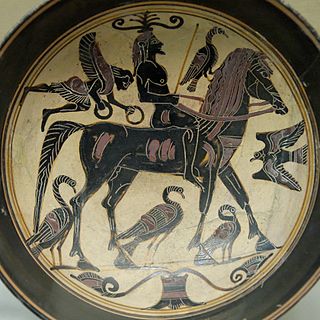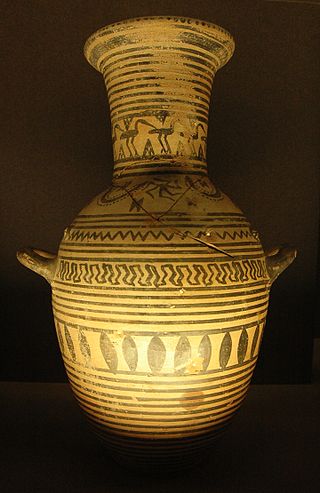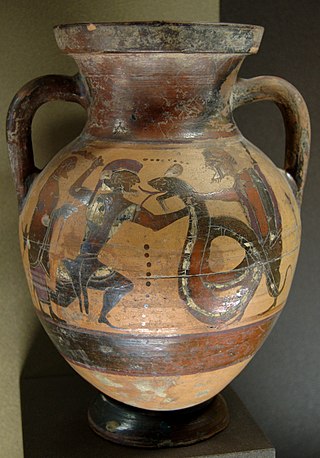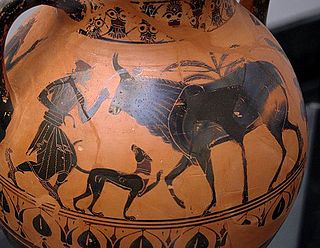
Black-figure pottery painting, also known as the black-figure style or black-figure ceramic, is one of the styles of painting on antique Greek vases. It was especially common between the 7th and 5th centuries BCE, although there are specimens dating in the 2nd century BCE. Stylistically it can be distinguished from the preceding orientalizing period and the subsequent red-figure pottery style.

Red-figure pottery is a style of ancient Greek pottery in which the background of the pottery is painted black while the figures and details are left in the natural red or orange color of the clay.

The Analatos Painter was an Attic vase painter of the Early Proto-Attic style.

The Rider Painter was a Laconian vase painter active between 560 and 530 BC. He is considered one of the five great vase painters of Sparta.

Boeotian vase painting was a regional style of ancient Greek vase painting. Since the Geometric period, and up to the 4th century BC, the region of Boeotia produced vases with ornamental and figural painted decoration, usually of lesser quality than the vase paintings from other areas.

The term Kabiria Group describes a type of Boeotian vases decorated in the black-figure technique. The term can also be used describe the artists producing vases of the type.

Euboean vase painting was a regional style of ancient Greek vase painting, prevalent on the island of Euboea.

East Greek vase painting was a regional style of ancient Greek vase painting, produced by the eastern Greeks. In spite of the region's wealth, the pottery was rather unremarkable in comparison to other areas. The clay is red-brown to pink and often contains mica inclusions. Many regional sub-styles of East Greek pottery existed.

The Northampton Group was a stylistic group of ancient Greek amphorae in the black-figure style.

The Pontic Group is a sub-style of Etruscan black-figure vase painting.
Thessalian vase painting was a regional style of Greek vase painting, prevalent in Thessaly.

Argive vase painting was a regional style of Greek Geometric vase painting from the city of Argos.
Cycladic vase painting was a regional style of Greek vase painting, produced in the Cycladic islands.

Samian vase painting was a regional style of ancient Greek vase painting; it formed part of East Greek vase painting.

Ionic vase painting was a regional style of ancient Greek vase painting.

The modern scholarly term Hâdra vases describes a group of Hellenistic painted hydriai. Apart from late Panathenaic prize amphorae, it is the only substantial group of figurally or ornamentally painted vases in the Greek world of the 3rd century BC.

Klazomenian vase painting was a regional style of ancient Greek vase painting, belonging to the East Greek representations of that form of art.

The East Greek Bird Bowl is an early type of vessel produced by East Greek vase painting.

Paestan vase painting was a style of vase painting associated with Paestum, a Campanian city in Italy founded by Greek colonists of Magna Graecia. Paestan vase painting is one of five regional styles of South Italian red-figure vase painting.
Thomas Mannack is a German classical archaeologist.
This page is based on this
Wikipedia article Text is available under the
CC BY-SA 4.0 license; additional terms may apply.
Images, videos and audio are available under their respective licenses.

















